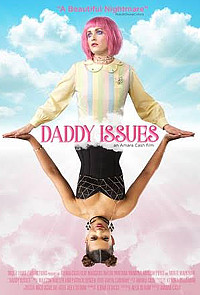| SHADOWS ON THE WALL | REVIEWS | NEWS | FESTIVAL | AWARDS | Q&A | ABOUT | TALKBACK | |||||||||||||||||||||||||||||
 Shadows off the beaten path Shadows off the beaten pathIndies, foreigns, docs, revivals and shorts...
On this page:
DADDY ISSUES |
OPUS ZERO |
WICKED WITCHES
| |||||||||||||||||||||||||||||
| See also: SHADOWS FILM FESTIVAL | Last update 2.Aug.19 | |||||||||||||||||||||||||||||
|
Daddy Issues Review by Rich Cline | 
| 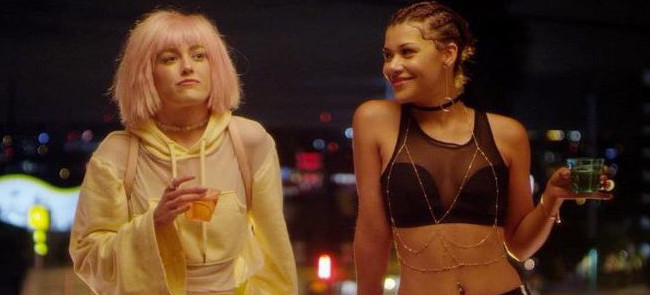 Colourfully stylised, this queer romantic comedy takes an enjoyably dreamy approach to its twisted story. Director Amara Cash creates a film that's loose and scruffy, with scenes that are earthy, natural, awkward and sometimes enjoyably camp. The story feels a little out of control, trying to force a fresh idea into a standard film-school script-writing format. But its originality makes it notable. In Orange County, California, 19-year-old Maya (Lawlor) is a pink-haired social media artist who dreams of studying art in Italy. She lives with her unsupportive mother and stepdad (Jones and Cassell), who both ignore and insult her. One day, Maya boldly decides to drive into Los Angeles to meet her crush, fashion designer Jasmine (Manning). And surprisingly, there's a strong spark of interest between them. But their blossoming romance is complicated by Jasmine's six-year fetishistic relationship with sugar daddy Simon (Pifko). And no one knows he's actually Maya's estranged father. But they'll soon find out. Visually, the film is a riot of pastels. Scenes are set in places that are multi-coloured, with a super on-trend Instagramable quality to them. There's also a flurry of eye-catching and very sexy outfits. As a range of relationships develop, intimacy takes shape in a variety of ways. Meanwhile, a problem begins to emerge: as Maya rebuilds her connection to her father, Jasmine is trying to deepen her relationship with him too. And the audience is waiting for this shoe to drop, which it does in an unexpected way. Lawlor and Manning bring an unrestrained, offhanded charm to their roles, which makes much of their interaction feel refreshingly improvised. Both their giddy happiness and wrenching emotional moments are played out with strikingly honesty, which makes both of them likeable even when they do messy things. Around them, each of the supporting characters is considerably more cartoonish. Cassell's Jim is downright clownish, while Pifko's Simon is at least engagingly pathetic, abusing drugs to deal his own daddy issues. There's an interesting exploration of love and sexuality here, as Maya struggles to come to terms with Jasmine's pansexual, polyamorous lifestyle. The climactic moment in the plot brings more than a little melodramatic craziness with it, as each of the secretive story strands finally comes out into the open, creating an entertaining knotted mess. So even if it becomes increasingly difficult to click into the story on an emotional level, the film holds the attention. And it marks Cash, Lawlor and Manning as talents to keep an eye on.
|
| Opus Zero Review by Rich Cline | 
|  dir-scr Daniel Graham prd Julio Chavezmontes with Willem Dafoe, Andres Almeida, Cassandra Ciangherotti, Brontis Jodorowsky, Irene Azuela, Noe Hernandez, Valentina Manzini, Leonardo Ortizgris, Carlos Aragon, Antonio Zuniga, Jose Concepcion Macias release Mex Nov.17 lciff, UK 9.Aug.19 17/Mexico 1h24
| 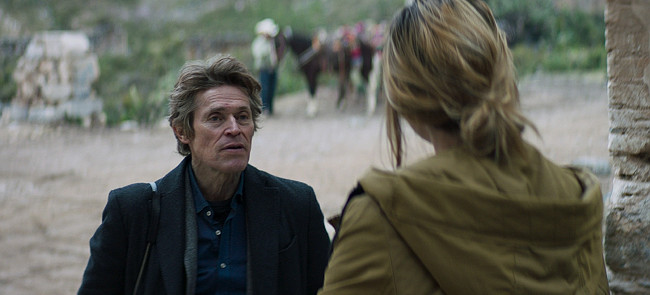 With an artistic approach, this film manages to be both provocative and challenging, even though it's not easy to isolate a straightforward narrative. Writer-director Daniel Graham assembles scenes together in ways that are sometimes deeply connected and at other times feel random. But the open-handed story's ideas are powerful, exploring the nature of creation through the eyes of a composer and a documentary filmmaker, among others. After his father dies suddenly, Paul (Dafoe) heads to a remote mountain village in Mexico and begins searching for a young Romanian woman (Manzini) who appeared in a photo his father sent him. Paul has been working for years to complete another composer's century-old unfinished symphony, and is in a dry spell. Then his paths cross with Daniel and Fernanda (Almeida and Ciangherotti), who arrive in the village to shoot the final scenes for their documentary. Like Paul with the symphony, they're not quite sure what they need to finish their movie. The film is shot in expansive wide-screen by Matias Penachino, who catches both the grandeur and subtle essence of both spectacular vistas, steep cobbled streets and darkly lit interiors. Each shot in the film is simply gorgeous, often catching the actors within wide angles over extended long takes. The style of the imagery ties even the most seemingly disconnected scene into the central flow, and then playfully adds a bit of trickery as the film within the film begins to flex its will. Dafoe is always terrific in these kinds of enigmatic, offbeat dramas, taking the audience on an internalised journey that feels momentous even if its indefinable. Paul is an enigmatic figure, playful in the way he speaks with people, revealing himself despite his attempts to obscure things about his life. The other strong role is Almeida's Daniel, a filmmaker who like Paul is unsure how to finish both this immediate project and indeed his life's work. And each of the side figures brings an intriguing quirk of personality into the overall picture. Graham's approach here may feel oddly elusive, swirling around between scenes without anchoring elements into a firm narrative. For example, the prologue and coda feel like they come from another film. But there's a raw, emotional truth running through every moment, carrying an open-minded viewer deep into ideas about invention and purpose, grappling with the power of both creating and experiencing art. It's also questioning the inexplicable world we live in, with its surprises and distractions, plus sideroads that might lead us somewhere important.
|
| Wicked Witches Review by Rich Cline | 
| 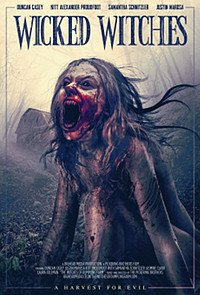 dir-scr Mark Pickering, Martin J Pickering prd Martin J Pickering with Duncan Casey, Justin Marosa, Kitt Alexander Proudfoot, Jasmine Clark, Samantha Schnitzler, Laura Coleman, Terri Bird, Yasmin Olds, Emily Pickering, Alice Moy, Catherine Harding, Robin Sturgess release US 9.Aug.19 18/UK 1h19
| 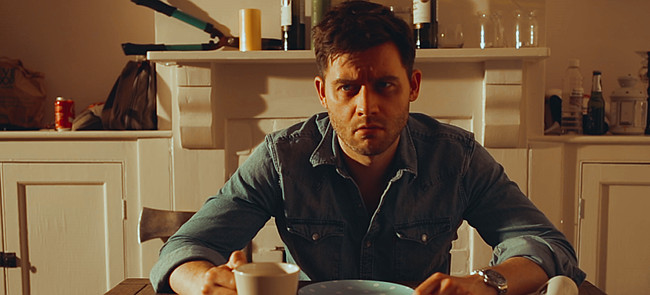 This British horror movie has a nicely retro vibe, harking back to bonkers 1970s secret society bloodbaths as a not-so-innocent man stumbles into a full-on nightmare. Stylishly shot in sun-drenched late-summer farmland, the film quietly builds to some superbly unhinged moments. There isn't much dialog, the plot isn't terribly complicated, and the directors leave most coherence off the screen entirely. But it's enjoyably cheap and nasty. After his wife throws him out, Mark (Casey) heads home to the English countryside, renting a room from old pal Ian (Marosa) at Dumpling Farm. But Ian's acting very, very strangely, and young men are going missing. Mark barely seems to notice, even after drinking probably tainted wine and smoking some equally suspect weed. What he doesn't know is that Ian is in service to a coven of vampiric women who are using the farm to lure in new prey. Then Mark's sex-mad friend Stevie (Proudfoot) arrives for a drug-fuelled party with the old gang. This supposedly epic party is a fairly sedate affair until Ian and the witches arrive for a, well, feast. The Pickering brothers begin at a relaxed pace, playing up Mark's dazed emotions and haunted dreams as well as his inability to see that everyone in this town is nuts. But then the way the film is edited makes Mark look mentally unhinged from the start, especially with his violent visions involving sharp-toothed women and squirming maggots. And that's nothing compared with what's coming. Casey plays the only normal person in the movie, and manages to layer the role with some nice touches as a man who regrets his irresponsible actions. On the other hand, no actor could convincingly play Mark's obliviousness. And Ian's bizarrely arch behaviour similarly defeats Marosa. Proudfoot is mildly more convincing as the vacuous party-boy Stevie. Meanwhile, the interchangeable women do a lot of posing and glowering, while the local village folk just look like nervous hamsters. When things finally cut loose into full on horror, the low-budget gore effects are gleefully nasty, splattering bright red blood and random body parts everywhere. Some solid makeup and a couple of well-placed digital gags add to the craziness. There's definitely a sense that the filmmakers have stretched out this material into a short feature using random montages and long stretches in which nothing much happens. But the idea is strong enough to hold the attention, even if only one character has a tenuous connection with the audience.
| 
See also: SHADOWS FILM FESTIVAL © 2019 by Rich Cline, Shadows
on the Wall
HOME | REVIEWS | NEWS | FESTIVAL | AWARDS
| Q&A | ABOUT | TALKBACK | | ||||||||||||||||||
